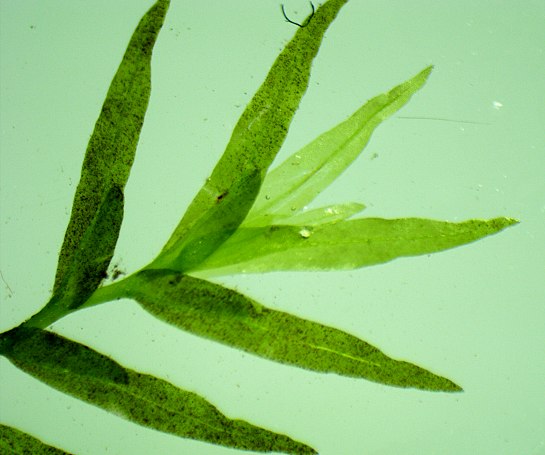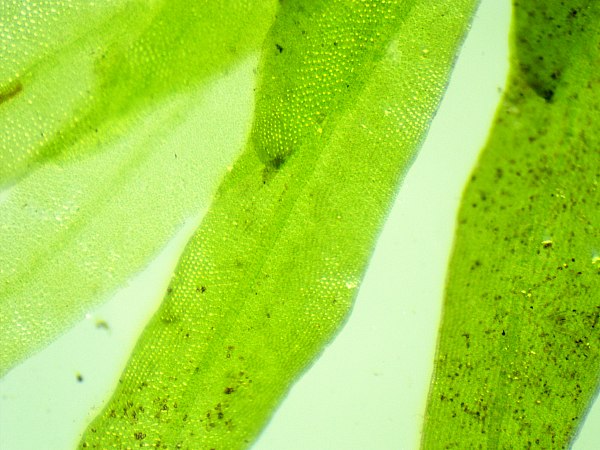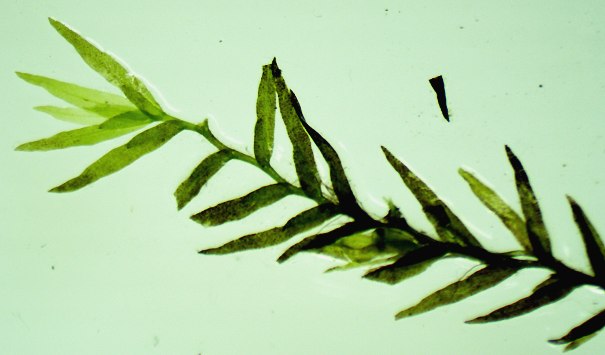
Occasionally, this aquatic moss will develop spore-bearing capsules on short stalks (setae) from the axils of its leaves; one to five of these stalked capsules can develop from the axil of a leaf. The setae are 1–1.5 mm. long. The capsules (including their beaked lids) are also 1–1.5 mm. long. The capsule bodies are cylindrical and cup-shaped, tapering at their bases. The beaked lids and upper bodies of these capsules are covered with membranous beaked hoods (calyptrae) that are hairless. The spore-bearing capsules detach from the mother plant when they are still immature and green. They are distributed by water. Eventually, the lids fall off their capsules, releasing the spores. These tiny spores are about 20 micrometers across. The primary leafy stems are anchored at their bases by fine brownish rhizoids. Sometimes this aquatic moss reproduces asexually when secondary leafy stems become detached from primary leafy stems after they develop rhizoids at their bases. Eventually, these secondary leafy stems become anchored to the substrate by their rhizoids to form separate clonal plants. The foliage of dried out plants soon becomes black, somewhat crinkled, and brittle.

Cultivation: The preference is full sun to light shade, shallow clear water, and a stable substrate consisting of submerged stones, submerged concrete blocks, sunken tree branches, etc. The pH of the water should be 6.0–8.0. Some lime in the water is tolerated, if not preferred. This aquatic moss is normally found in streams where there is some movement of water (either slow or fast), although it will adapt to more stagnant water in aquariums. Sometimes filamentous green algae will cling to the foliage of this moss. It is intolerant of drying out.
Range & Habitat: The native Water Pocket Moss (Fissidens fontanus) is occasional in scattered counties throughout Illinois, although it has not been reported thus far from the NW section and many parts of the central section of the state (see Distribution Map). However, this aquatic moss can be overlooked and it is probably more common than herbarium records indicate. Water Pocket Moss is widely distributed in North America, and it also occurs in Europe. Habitats include slow-moving to fast-moving streams, creeks, springs, lakes with clear water, rocky ground behind or adjacent to waterfalls, wet rock walls at the head of springs, and emersed wet rocks in streams. In some of the Great Lakes, this moss has been found in water up to 60' deep. Habitats include high quality wetlands in natural areas and lower quality wetlands where the water is somewhat polluted. This moss is normally submerged in water, where it anchors itself to rocks, stones, tree branches, concrete blocks, and other persistent objects. Far less often, it appears above the surface of water in very wet protected locations that are near bodies of water.

Faunal Associations: The Trumpeter Swam feeds on pocket mosses (Fissidens spp.) that are aquatic (Schorger, 1964). It seems likely that swans and some ducks feed on these mosses as well. The tufts of leafy stems provide good cover for aquatic insect larvae, minnows, and other small organisms that live in water.
Photographic Location: Indoors. This moss was originally found in shallow rapid water of the Boneyard Creek in Urbana, Illinois, where it was clinging to submerged rocks and tree branches in fairly sunny areas.

Comments: When it occurs in highly protected environments, such as indoor aquariums, Water Pocket Moss (Fissidens fontanus) is highly attractive. However, in the wild it tends to be less attractive because it is often coated with filamentous green algae and its older foliage turns black. This is the most aquatic of the pocket mosses (Fissidens spp.) in Illinois and it is relatively easy to identify because of its non-overlapping leaves. When other pocket mosses occur in water, such as Fissidens grandifrons and Fissidens taxifolius, they have shorter and more erect stems, while their leaves are more stiff, overlapping, and shorter. Water Pocket Moss has some resemblance to water mosses (Fontinalis spp.). It differs from this latter group of mosses by having its leaves arranged on opposite sides of a stem along a single plane, rather than on 3 or more sides of a stem. In addition, like other pocket mosses, the leaves of Water Pocket Moss have conspicuous sleeves that are lacking in the leaves of water mosses. Other common names of Fissidens fontanus include Phoenix Moss and Palm Moss. Such names refer to the superficial resemblance of its leaves to those of indoor parlor palms.